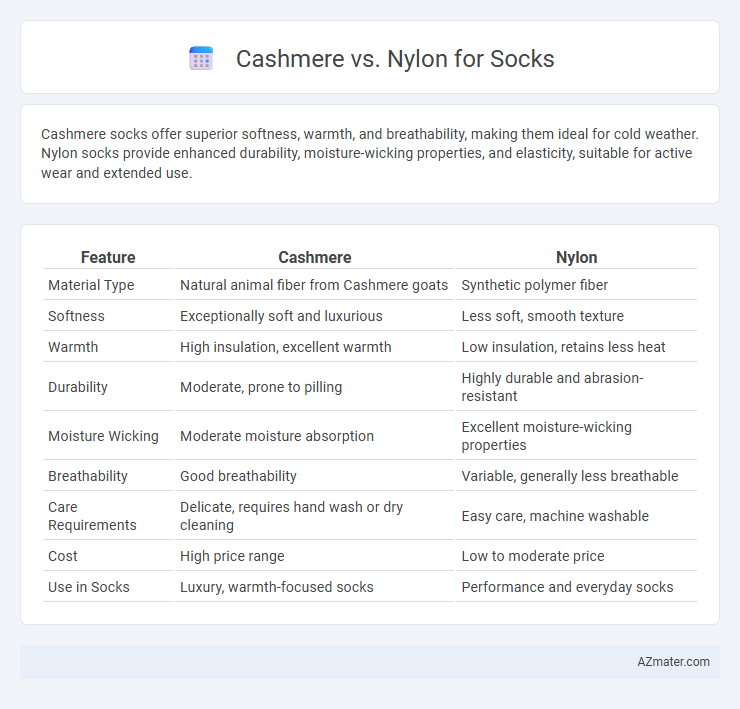Cashmere socks offer superior softness, warmth, and breathability, making them ideal for cold weather. Nylon socks provide enhanced durability, moisture-wicking properties, and elasticity, suitable for active wear and extended use.
Table of Comparison
| Feature | Cashmere | Nylon |
|---|---|---|
| Material Type | Natural animal fiber from Cashmere goats | Synthetic polymer fiber |
| Softness | Exceptionally soft and luxurious | Less soft, smooth texture |
| Warmth | High insulation, excellent warmth | Low insulation, retains less heat |
| Durability | Moderate, prone to pilling | Highly durable and abrasion-resistant |
| Moisture Wicking | Moderate moisture absorption | Excellent moisture-wicking properties |
| Breathability | Good breathability | Variable, generally less breathable |
| Care Requirements | Delicate, requires hand wash or dry cleaning | Easy care, machine washable |
| Cost | High price range | Low to moderate price |
| Use in Socks | Luxury, warmth-focused socks | Performance and everyday socks |
Introduction: Comparing Cashmere and Nylon for Socks
Cashmere socks offer unparalleled softness and natural insulation, making them ideal for luxurious comfort and warmth in cold weather. Nylon socks provide durability, moisture-wicking properties, and enhanced elasticity, supporting long-lasting wear and a snug fit. Understanding the distinct benefits of Cashmere and Nylon helps in selecting socks tailored to specific needs such as comfort, performance, or durability.
Material Origins: Cashmere vs Nylon Explained
Cashmere is a natural fiber derived from the undercoat of Cashmere goats, prized for its softness, warmth, and breathability, making it ideal for luxury socks. Nylon is a synthetic polymer made from petrochemicals through a process of polymerization, valued for its durability, elasticity, and moisture-wicking properties. The natural origin of cashmere provides insulation and comfort, while nylon enhances longevity and stretch in sock materials.
Softness and Comfort Differences
Cashmere socks offer exceptional softness and natural warmth due to their fine, lightweight fibers, making them ideal for delicate skin and premium comfort. Nylon socks, while less soft, provide enhanced durability and elasticity, contributing to a snug fit and moisture-wicking performance. The blend of cashmere with nylon often balances luxurious softness with practical resilience and comfort for everyday wear.
Durability: Which Material Lasts Longer?
Cashmere socks offer luxurious softness but tend to wear out faster due to delicate fibers prone to pilling and damage from frequent washing. Nylon socks are known for superior durability, resisting abrasion, stretching, and moisture better than natural fibers. For longevity and consistent performance, nylon is the preferable choice in sock materials.
Breathability and Moisture Management
Cashmere socks provide superior breathability due to their natural fibers, which allow air circulation and help regulate temperature, keeping feet dry and comfortable. Nylon, a synthetic material, offers less breathability but excels in moisture management by wicking sweat away from the skin to prevent dampness. For optimal foot health, cashmere promotes a natural airflow while nylon enhances moisture control during physical activity.
Warmth and Insulation Properties
Cashmere socks provide superior warmth and insulation due to their natural fine fibers that trap heat efficiently while remaining lightweight and breathable. Nylon socks, while durable and moisture-resistant, offer less thermal insulation compared to cashmere and tend to retain less warmth in cold conditions. For optimal warmth and comfort, cashmere is preferred for insulating properties in socks.
Care and Maintenance Requirements
Cashmere socks require gentle hand washing with cold water and mild detergent to maintain their softness and prevent fiber damage, while nylon socks can typically be machine washed and dried without special precautions. Cashmere fibers are delicate and prone to pilling, necessitating careful handling and air drying, whereas nylon's synthetic composition makes it more durable and resistant to shrinkage and wear. Proper maintenance of cashmere extends its lifespan and comfort but demands more effort compared to the low-maintenance care routine of nylon socks.
Environmental Impact: Sustainability Concerns
Cashmere socks, derived from the undercoat of cashmere goats, involve significant environmental concerns due to overgrazing, which leads to land degradation and loss of biodiversity. Nylon, a synthetic fiber produced from petrochemicals, contributes to microplastic pollution and has a high carbon footprint because of its energy-intensive manufacturing process. Choosing sustainable sock materials requires considering the trade-offs between renewable natural fibers like cashmere with ecological impacts and synthetic fibers like nylon with pollution and fossil fuel dependence.
Price Comparison: Cost of Cashmere vs Nylon Socks
Cashmere socks typically carry a higher price tag than nylon socks due to the luxury and rarity of cashmere fibers, often ranging from $50 to $150 per pair. Nylon socks offer a more budget-friendly option, with prices commonly between $5 and $20 per pair, reflecting the synthetic material's lower production costs. The significant price difference highlights the trade-off between the premium warmth and softness of cashmere versus the affordability and durability of nylon in sock manufacturing.
Best Uses and Recommendations
Cashmere socks provide superior warmth and softness, making them ideal for cold weather and luxury comfort. Nylon socks offer enhanced durability, moisture-wicking, and elasticity, perfect for athletic activities and everyday wear. For cold climates or formal occasions, choose cashmere, while nylon suits high-performance and casual use.

Infographic: Cashmere vs Nylon for Sock
 azmater.com
azmater.com